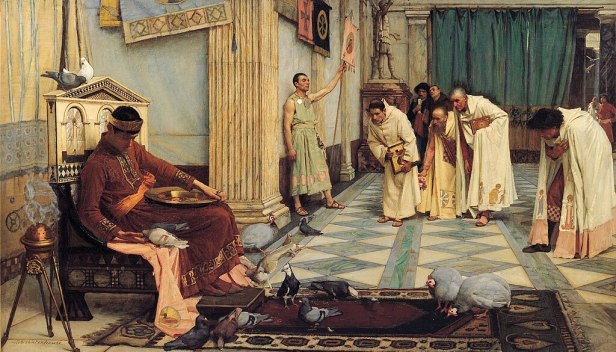
“The Favorites of the Emperor Honorius” by John William Waterhouse portrays Honorius feeding birds which are on the rug in front of him. The colours of the Emperor’s clothes and the carpet dominate the foreground is in contrast to the councillors seeking his attention, and who along with the attendants are dressed in paler shades. However, the Emperor is also shown as indecisive, his face in shadow, is contrasted to Augustus’s statue in the background.
Honorius is considered as one of the worst emperors during the last period of the Eastern Roman Empire, and during his reign, Rome was sacked for the first time in 800 years. Honorius, whose name in Latin is Flavius Honorius Augustus, (384 – 423) was the Western Roman Emperor from 393 to 423. He was the younger son of emperor Theodosius I, and brother of Arcadius, who was the Eastern Emperor in Constantinople. Honorius’s reign was precarious and chaotic during a period in which the Western Roman Empire was in rapid decline.
In an early history of this period, it is claimed that on hearing the news that Rome had “perished”, Honorius was initially shocked, thinking the news was about a favourite chicken which he had named “Roma”. This painting depicts Honorius feeds his pigeons, indifferent to the news that Rome has fallen. Gibbon states:
“the amusement of feeding poultry became the serious and daily care of the monarch of the West ……. passed the slumber of his life, a captive in his palace, a stranger in his country, and the patient, almost the indifferent, spectator of the ruin of the Western empire, which was repeatedly attacked, and finally subverted, by the arms of the Barbarians”
After the Visigothic invasion of Italy in 402, Honorius and the imperial court retired to the remote and heavily defended city of Ravenna. Honorius was timid and generally took little part in public affairs, he was usually passive in nature, and left the running of the empire to his generals and assistants.
Waterhouse worked in the Pre-Raphaelite style, several decades after the breakup of the Pre-Raphaelite Brotherhood, which included artists such as Dante Gabriel Rossetti, John Everett Millais and William Holman Hunt. Waterhouse embraced the Pre-Raphaelite style despite the fact that it had gone out of fashion in the British art scene.
Pre-Raphaelites
The Pre-Raphaelites was a group of English painters, poets, and art critics, founded in 1848. The group’s intention was to reform art by rejecting what it considered the mechanistic approach first adopted by the artists who succeeded Raphael and Michelangelo, hence the name “Pre-Raphaelite”. The Pre-Raphaelite Brotherhood sought a return to the abundant detail, intense colours and complex compositions of Pre-Raphaelite Italian art.
The Pre-Raphaelites focused on painting subjects from modern life and literature often used historical costumes for accuracy. They painted directly from nature itself, as accurately as possible and with intense attention to detail.
The Pre-Raphaelites defined themselves as a reform movement, created a distinct name for their art, and published a periodical to promote their ideas. A later, medieval influence extended the movement’s power into the twentieth century with artists such as John William Waterhouse.
Exploring Pre-Raphaelite Art
- By John Everett Millais
- Isabella
- Christ in the House of His Parents
- The Martyr of Solway
- Ophelia
- Blow Blow Thou Wind
- By John William Waterhouse
- The Lady of Shalott
- The Favorites of the Emperor Honorius
- Circe Invidiosa
- Hylas and the Nymphs
- Dante Gabriel Rossetti
- Lady Lilith
- Marie Spartali Stillman
- Love’s Messenger
The Favorites of the Emperor Honorius
- Title: The Favorites of the Emperor Honorius
- Artist: John William Waterhouse
- Medium: Oil on canvas
- Date: 1883
- Style: Pre-Raphaelite
- Dimensions: 117 cm × 202 cm (46 in × 80 in)
- Museum: Art Gallery of South Australia
John William Waterhouse
- Name: John William Waterhouse
- Movement: Pre-Raphaelite
- Born: 1849 – Rome, Papal States
- Died: 1917 (aged 67) – London, England, United Kingdom
- Nationality: British
- Notable works:
- The Lady of Shalott
- The Favorites of the Emperor Honorius
- Circe Invidiosa
- Hylas and the Nymphs
~~~
“Art is not a study of positive reality, it is the seeking for ideal truth.”
– John Ruskin
~~~
Photo Credit: John William Waterhouse [Public domain], via Wikimedia Commons